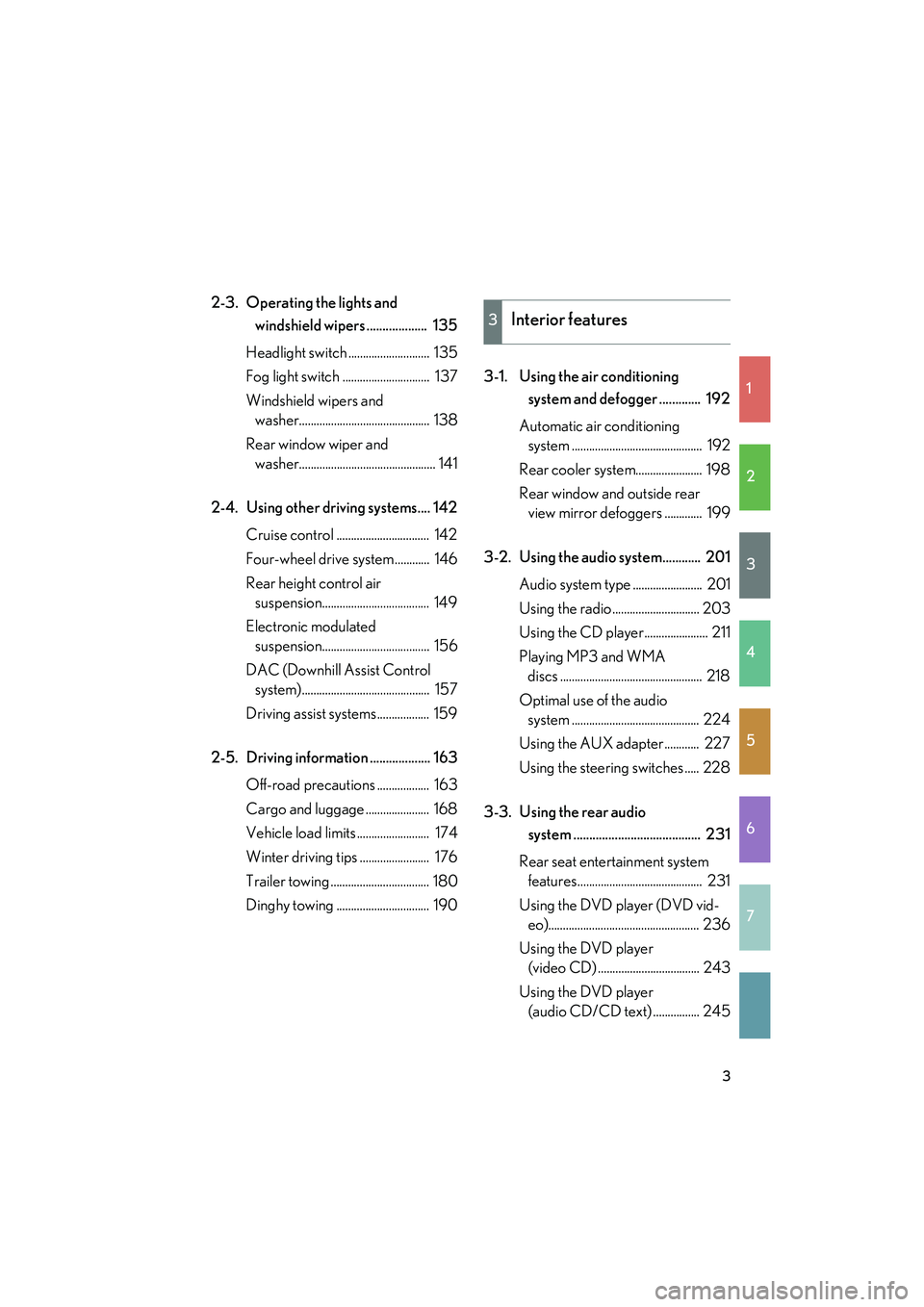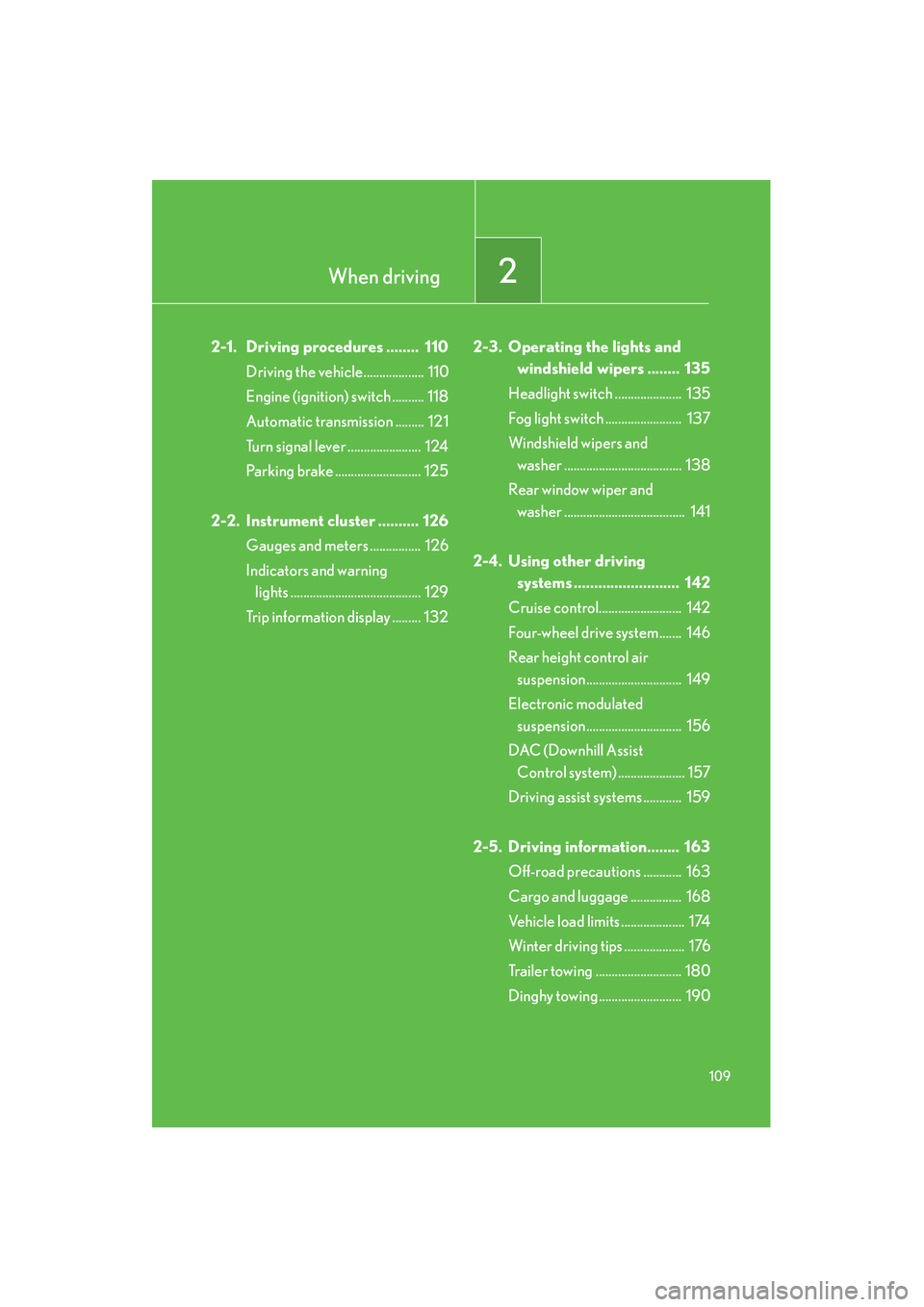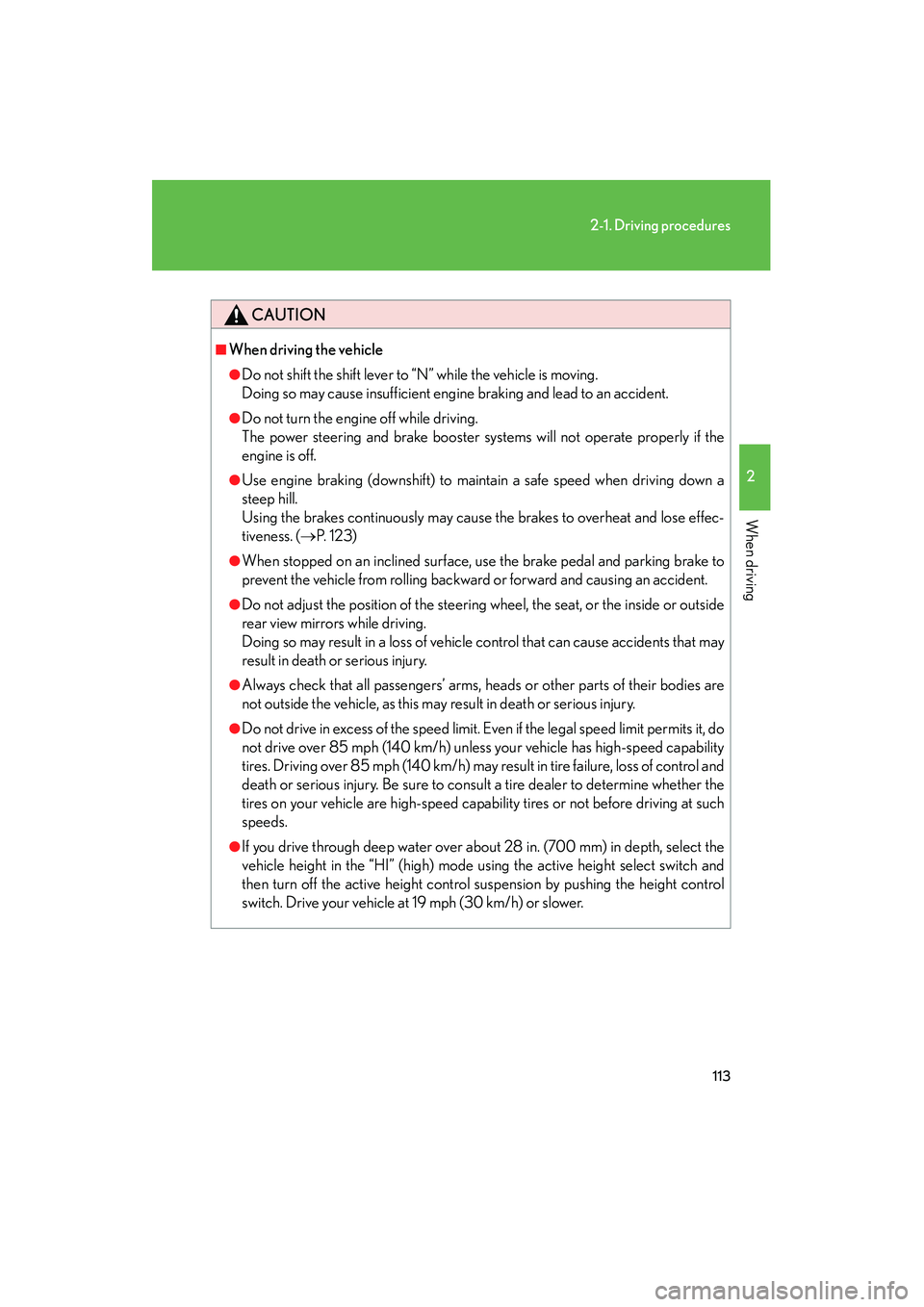2008 Lexus GX470 rear height
[x] Cancel search: rear heightPage 4 of 458

1
2
3
4
5
6
7
3
2-3. Operating the lights and windshield wipers ................... 135
Headlight switch ............................ 135
Fog light switch .............................. 137
Windshield wipers and washer............................................. 138
Rear window wiper and washer............................................... 141
2-4. Using other driving systems.... 142 Cruise control ................................ 142
Four-wheel drive system............ 146
Rear height control air suspension..................................... 149
Electronic modulated suspension..................................... 156
DAC (Downhill Assist Control system)............................................ 157
Driving assist systems.................. 159
2-5. Driving information ................... 163 Off-road precautions .................. 163
Cargo and luggage ...................... 168
Vehicle load limits ......................... 174
Winter driving tips ........................ 176
Trailer towing .................................. 180
Dinghy towing ................................ 190 3-1. Using the air conditioning
system and defogger ............. 192
Automatic air conditioning system ............................................. 192
Rear cooler system....................... 198
Rear window and outside rear view mirror defoggers ............. 199
3-2. Using the audio system............ 201 Audio system type ........................ 201
Using the radio.............................. 203
Using the CD player...................... 211
Playing MP3 and WMA discs ................................................. 218
Optimal use of the audio system ............................................ 224
Using the AUX adapter............ 227
Using the steering switches ..... 228
3-3. Using the rear audio system ........................................ 231
Rear seat entertainment system features........................................... 231
Using the DVD player (DVD vid- eo).................................................... 236
Using the DVD player (video CD) ................................... 243
Using the DVD player (audio CD/CD text) ................ 245
3Interior features
Page 110 of 458

When driving2
109
2-1. Driving procedures ........ 110Driving the vehicle................... 110
Engine (ignition) switch .......... 118
Automatic transmission ......... 121
Turn signal lever ....................... 124
Parking brake ........................... 125
2-2. Instrument cluster .......... 126 Gauges and meters ................ 126
Indicators and warning lights ......................................... 129
Trip information display ......... 132 2-3. Operating the lights and
windshield wipers ........ 135
Headlight switch ..................... 135
Fog light switch ........................ 137
Windshield wipers and washer ..................................... 138
Rear window wiper and washer ...................................... 141
2-4. Using other driving systems .......................... 142
Cruise control.......................... 142
Four-wheel drive system....... 146
Rear height control air suspension.............................. 149
Electronic modulated suspension.............................. 156
DAC (Downhill Assist Control system) ..................... 157
Driving assist systems ............ 159
2-5. Driving information........ 163 Off-road precautions ............ 163
Cargo and luggage ................ 168
Vehicle load limits .................... 174
Winter driving tips ................... 176
Trailer towing ........................... 180
Dinghy towing.......................... 190
Page 114 of 458

113
2-1. Driving procedures
2
When driving
CAUTION
■When driving the vehicle
●Do not shift the shift lever to “N” while the vehicle is moving.
Doing so may cause insufficient engine braking and lead to an accident.
●Do not turn the engine off while driving.
The power steering and brake booster systems will not operate properly if the
engine is off.
●Use engine braking (downshift) to maintain a safe speed when driving down a
steep hill.
Using the brakes continuously may cause the brakes to overheat and lose effec-
tiveness. ( →P. 1 2 3 )
●When stopped on an inclined surface, use the brake pedal and parking brake to
prevent the vehicle from rolling backward or forward and causing an accident.
●Do not adjust the position of the steering wheel, the seat, or the inside or outside
rear view mirrors while driving.
Doing so may result in a loss of vehicle control that can cause accidents that may
result in death or serious injury.
●Always check that all passengers’ arms, heads or other parts of their bodies are
not outside the vehicle, as this may result in death or serious injury.
●Do not drive in excess of the speed limit. Even if the legal speed limit permits it, do
not drive over 85 mph (140 km/h) unless your vehicle has high-speed capability
tires. Driving over 85 mph (140 km/h) may result in tire failure, loss of control and
death or serious injury. Be sure to consult a tire dealer to determine whether the
tires on your vehicle are high-speed capability tires or not before driving at such
speeds.
●If you drive through deep water over about 28 in. (700 mm) in depth, select the
vehicle height in the “HI” (high) mode using the active height select switch and
then turn off the active height control suspension by pushing the height control
switch. Drive your vehicle at 19 mph (30 km/h) or slower.
Page 150 of 458

149
2-4. Using other driving systems
2
When driving
Rear height control air suspension
The rear height control air suspension adjusts the rear vehicle height in
accordance with driving conditions. There are 3 selectable modes, “HI”
(high), “N” (normal), and “LO” (low).
■ Height control switch
“▲ ” (Up) switch
“ ▼ ” (Down) switch
“OFF” switch
Push while the vehicle is
stopped. The “OFF” indicator
light will come on, and the vehi-
cle height will be fixed in the
current mode. Push the switch
again to turn the system back
on.
Page 152 of 458

151
2-4. Using other driving systems
2
When driving
Vehicle height modesPress “ ▲” to step up one mode, and “ ▼” to step down one mode.
(e.g. When in the low mode, press “ ▲” once to switch to the normal
mode, and twice to switch to the high mode.)
■ “HI” (high) mode
Rear vehicle height is 1.6 in. (40 mm) higher than the normal mode
height.
This mode is suitable when driving on bumpy roads or through water.
High mode is only available when the vehicle speed is under 19 mph
(30 km/h).
■ “N” (normal) mode
The standard vehicle height. This mode is suitable for ordinary driving.
■ “LO” (low) mode
Rear vehicle height is 0.8 in. (2 0 mm) lower than the normal mode
height.
This mode allows easy access to the vehicle.
Low mode is only available when the vehicle speed is under 7 mph (12
km/h).
Conditions for changing the vehicle height mode
Some modes may not be selectable depending on the vehicle speed.
Refer to the following table.
Low modeNormal modeHigh mode
Under 7 mph (12 km/h)Ye sYe sYe s
Under 19 mph (30 km/h)NoYe sYe s
19 mph (30 km/h) or overNoYe sNo
Page 153 of 458

152
2-4. Using other driving systems
Height control indicator lightsIf you change the vehicle height mode, the indicator lights change as fol-
lows: • The current mode indicator light will turn off, and the selected modeindicator light will begin flashing.
• Once the change in vehicle height is complete, the selected mode indicator light will change from flashing to continuously lit.
■Operating conditions
●The engine must be running.
●Vehicle speed must be within the acceptable range for the selected mode.
■Automatic change in vehicle height
If the vehicle speed exceeds 19 mph (30 km/h) when in the high mode, or 7 mph
(12 km/h) when in the low mode, normal mode is automatically selected.
■Turning off the rear height control air suspension
●The system will remain off until the switch is pushed again, even if the engine
switch is turned off.
●Even if the rear height control air suspension is turned off, the system automati-
cally selects the normal mode if the vehicle’s speed exceeds 19 mph (30 km/h).
■Automatic leveling function
The vehicle is adjusted to a fixed height for each mode, regardless of the number of
occupants and the luggage load.
Page 154 of 458

153
2-4. Using other driving systems
2
When driving
■If the vehicle height does not change
If the area around the rear suspension is coated with ice, or the undercarriage has
come into contact with the road surface, the rear height control suspension will not
operate. In this case, the indicator lights will change as follows:
●The current mode indicator light will turn off, and the target mode indicator light
will begin flashing.
●The target mode indicator light will turn off, and the original mode indicator light
will be lit once more. (The vehicle height does not change.)
If the rear height control air suspension cannot be operated even after removing
the ice or progressing to a smooth driving surface, turn off and restart the engine.
■ Parking and stopping tips
●If you immediately stop the engine after off-road driving, or park the vehicle for
a long time, the vehicle height may gradually lower. When parking, make sure
there is nothing under the vehicle that may come in contact with the underbody.
The vehicle will return to the set height when the engine is started.
●The vehicle height may change as the temperature changes when the engine is
stopped. The vehicle will return to the set height when the engine is started.
■When lowering the vehicle
Even if the engine is stopped while the vehicle height is being lowered, operation
will continue for up to 25 seconds. If any of the side doors or the back door is
opened within this 25 seconds, operation will continue for a further 15 seconds.
■ Rear height control failure warning
●If a malfunction occurs in the rear height control air suspension, normal mode is
automatically selected.
The height control “OFF” indicator will blink, and the vehicle height control can-
not be activated until the malfunction is corrected. Have the vehicle checked at
your Lexus dealer as soon as possible.
●If the height control “OFF” indicator lig ht does not come on when the engine
switch is turned to the “ON” position, there is a malfunction in the rear height
control air suspension. You can continue normal driving, however have the vehi-
cle checked by your Lexus dealer as soon as possible.
Page 155 of 458

154
2-4. Using other driving systems
CAUTION
Failure to observe the following precautions may result in an accident.
■ Using the “HI” (high) mode
This mode should only be used for rough off-road conditions. Because the vehicle’s
center of gravity is higher when in the high mode, the vehicle may become unstable
when turning abruptly.
■When loading cargo on the roof luggage carrier
Do not select the “HI” (high) mode. Because the vehicle’s center of gravity is higher
when in the high mode, the vehicle may become unstable when turning abruptly
and unexpected loss of control or vehicle rollover may occur.
■When jacking up the vehicle or installing tire chains
Turn off the rear height control air suspension and stop the engine, otherwise the
vehicle height may change due to the automatic leveling function.
■ When driving through water deeper than 28 in. (700 mm)
Select the “HI” (high) mode, turn off the rear height control air suspension and drive
at 19 mph (30 km/h) or slower. Otherwise, the vehicle height may change due to
the automatic leveling function.
■If your vehicle must be towed
Put the vehicle height in the normal mode and turn off the rear height control air
suspension, otherwise the vehicle height may change due to the automatic leveling
function.
■If your vehicle becomes stuck in a ditch
Turn off the rear height control air suspension, otherwise the vehicle height may
change due to the automatic leveling function.